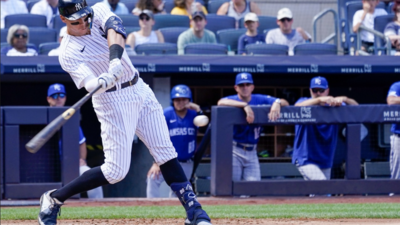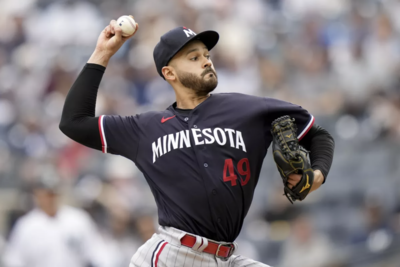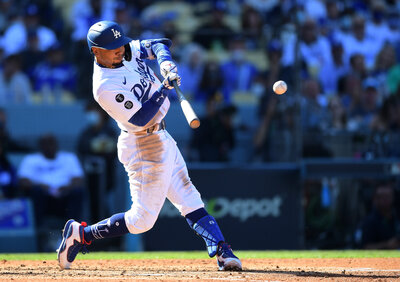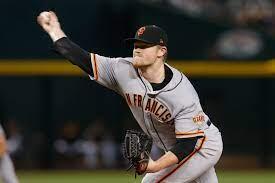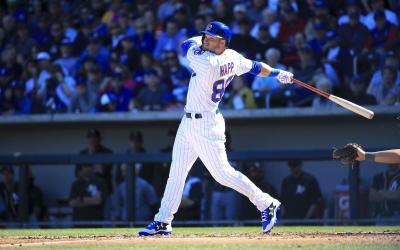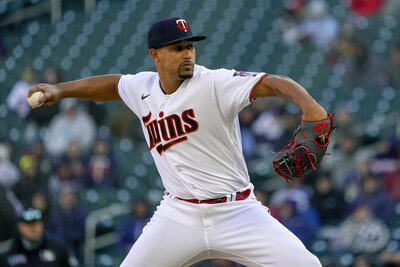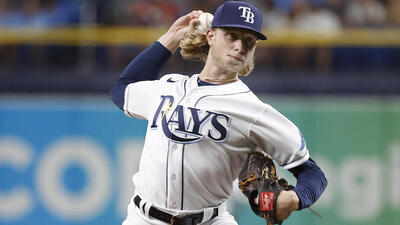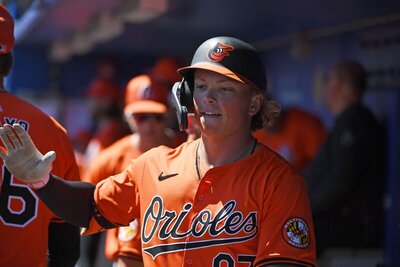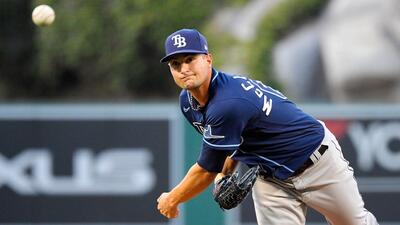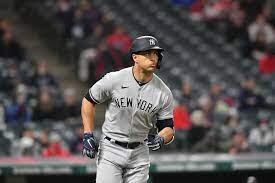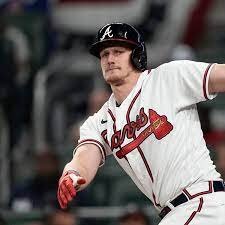Francisco Alvarez (C-NYM) enters the 2025 campaign as a question mark after a torn thumb ligament suffered in April forced him to miss a chunk of last season. He's reportedly retooling his swing this offseason at the suggestion of J.D. Martinez to lift the ball more and use the opposite field more often. After bursting onto the scene with 25 homers in just 423 PA as a 21 year-old rookie in 2023, Alvarez hit just 11 dingers across 342 PA in his sophomore campaign. The thumb injury - which required surgery - likely contributed to that as his hard-hit rate (per Statcast) was down to 42% last season (from 45% in his rookie year) while his average exit velo was down to under 89 mph (from 90mph in 2023). Most problematic was a major dip in his launch angle, which went from 12.5 in 2023 to just 6.9 last season, making his 52% groundball rate (up from 44% in 2023) unsurprising. The good news is that Alvarez trimmed his swinging-strike rate to nearly 12% (from 13%) while elevating his contact rate from to 73% (was 71%), making more contact on pitches inside the zone (up to 83% from 81.5%). Now just 23, Alvarez still has a ton of potential and fantasy owners should view him as a high-upside lottery ticket to be taken as the #8-10 catcher off the board in fantasy drafts. Hand injuries notoriously sap power and that likely contributed to his underwhelming stat line a season ago. Roster him expecting a .230 average to go with 20 bombs, but a retooled swing could lead to more.
Freddie Freeman (1B-LAD) appears to be finally slowing down as his .282 average last season was his lowest since 2015 and his 22 homers were his second fewest (not counting the abbreviated 2020 campaign) since that same year. A late-season ankle injury that required surgery in December likely suppressed his numbers a bit, but that occurred so late in the year that it can't account for a lot. His 137 wRC+ indicates that he was still productive in his age-34 season, but Freeman's 41.5% hard-hit rate, 9% barrel rate, and average exit velocity of 89.5 mph were all his lowest Statcast metrics since 2018. While his 9% swinging-strike rate and 82% contact rate were both in line with recent figures, his 86% z-contact% is down a tick from the last couple of campaigns. Normally a line-drive machine (27% career), that figure was under 23% last season. A .306 BABIP that was his lowest since 2012 likely reflects a little bad luck, but he also didn't square up the ball as well last season as in years past. Expect a .290 average with 20 or so bombs from Freeman this season and you shouldn't be disappointed, but his days of being an MVP candidate are likely past.
Jordan Westburg (2B/3B-BAL) enjoyed a breakout sophomore campaign in which he batted .264 with 18 homers, 63 RBI, and 57 runs scored across 447 PA, with a wRC+ of 125 attesting to his productivity at the dish. Westburg missed considerable time as he suffered a fracture in his hand, otherwise his season line would have likely been more impressive. When healthy, he assembled a healthy Statcast profile that included a 46% hard-hit rate, 12% barrel rate, and average exit velocity of 91 mph to go with a launch angle of 13.1 that generated a combined liner-flyball rate of 58%. While he fanned at an acceptable 21.5% clip, Westburg rarely walked (under 5%) while his contact rate (74%) and swinging-strike rate (13%) do not bode well for his average. If he can log a full age-26 season, Wesburg appears to be a lock for a batting average around .260 and 20ish homers, although the LF wall moving in at Camden Yards could help to boost his power output.
Zach Neto (SS-LAA) put together a strong sophomore season in which he batted .249 with 23 homers, 77 RBI, 70 runs scored, and 30 steals across 602 PA. He did undergo offseason surgery on his right (throwing) shoulder and appears likely to miss the start of the campaign, so account for that on draft day. Neto's peripherals are pretty underwhelming overall, with a 74% contact rate and 12.5% swinging-strike rate to go with a 38.5% hard-hit rate, 8.5% barrel rate, and average exit velocity of 88.5 mph per Statcast. His 23.5% strikeout rate and 6.5% walk rate also aren't impressive. But Neto will begin only his third year of professional ball as his age-24 season approaches, and given something close to a full season he should log something like a .250 average while putting up a 20-20 campaign. As his 114 wRC+ suggests, he's productive but the underlying metrics don't suggest a star in the making. Early reports indicate that he could bat 5th or 6th - instead of 2nd as he did toward the end of last season - so that could affect his runs and RBI numbers.
Mark Vientos (3B-NYM) is expected to remain the club's primary 3B after the Mets re-signed Pete Alonso. Vientos showed some promise in his age-24 season a year ago, registering a .266 average to go with 27 dingers, 71 RBI, and 58 runs scored across 454 PA, with a healthy 133 wRC+. While his strikeout rate remained high at 29.5%, it was down from 30.5% in his 233-PA run as a rookie, and his walk rate climbed from just 4.5% to a more respectable 7.5%. Vientos showed modest improvement in making contact as his swinging-strike rate dipped from 17.5% to 16% and his contact rate ticked upward from 77.5% to a shade over 78%. His Statcast profile was impressive, however, as he registered a 46.5% hard-hit rate, 14% barrel rate, and average exit velo just over 91 mph. His launch angle of 11.4 produced a combined liner and flyball rate of 56%. The average seems likely to come in at .250 or less given his contact issues, but Vientos's ability to put a charge into the ball should help him approach or even surpass 30 homers.
Wyatt Langford (OF-TEX) might not have impressed in his much-heralded debut, but the then 22-year old hinted at future stardom down the stretch. On the year, Langford batted .253 with 16 homers, 74 RBI, 74 runs scored, and 19 steals across 557 PA, with an above-average wRC+ of 110. He commanded the plate fairly well with a 20.5% strikeout rate against a 9% walk rate while registering a 79.5% contact rate and 9% swinging-strike rate. His quality of contact was decent as he recorded a 43.5% hard-hit rate, 9.5% barrel rate, and average exit velocity of 89.5 mph per Statcast. After a ho-hum first part of the season in which he hit .247 with 6 dingers, 44 RBI, 37 runs scored, and 9 stolen bags across 352 PA through the end of July, Langford came alive after the calendar turned to August, hitting .263 with 10 big flies, 30 RBI, 37 runs scored, and 10 steals in his final 205 PA of the campaign. During that span, his Statcast profile featured an improved 47.5% hard-hit rate, 13% barrel rate, and average exit velo of 91 mph with a launch angle of 16.3 that generated a combined flyball and liner rate of 57%. Look for Langford to take a step forward in 2025 as he should hit .265+ (his .296 BABIP was low for a guy with his kind of wheels and contact profile) with 25+ homers and 20 steals.
Lawrence Butler (OF-OAK) impressed as a 23 year-old sophomore in 2024, registering a .262 average to go with 22 homers, 57 RBI, 63 runs scored, and 19 steals across 451 PA in his first extended taste of big-league action. Butler fanned a decent bit (24%) but also drew a few walks (8%) while his swinging-strike (12%) and contact (75%) rates were also not great but not bad. He shined, however, in quality of contact, as Statcast shows a 47.5% hard-hit rate, 11% barrel rate, and average exit velocity of 91 mph. An average launch angle of 11.3 is a little concerning in terms of future power output, but he did muster a combined liner-flyball rate of 56% last season and his wheels should help to keep his average from dropping too low. Expect a .250 or so average to go with a 20-20 season in 2025, although the homer total could come in closer to 25, especially with the move from the spacious Oakland Coliseum to more hitter-friendly Sutter Park in Sacramento.
Pete Crow-Armstrong (OF-CHC) may not begin the 2025 campaign as the club's leadoff hitter, but he's nevertheless an intriguing player for fantasy. In his rookie campaign as a 22 year-old, Crow-Armstrong showed significant growth over the course of the season that is not reflected in his season line of a .237 average, 10 homers, 47 RBI, 46 runs scored, and 27 steals in 410 PA. His 87 wRC+, 24% strikeout rate against a 5% walk rate, 37% hard-hit rate per Statcast, 16% swinging-strike rate, and 73% contact rate on the season were all unimpressive. But he took a step forward late in the campaign, batting .284 with 7 dingers, 27 RBI, 32 runs scored, and 7 stolen bases across 197 PA from August 1st onward. During that span, he posted a 122 wRC+, lowered his strikeout rate to 22.5%, raised his walk rate to 6%, and elevated his hard-hit rate (per Statcast) to 42%. It would be unwise to put too much stock in his last two months given his swing choices and contact issues, but Crow-Armstrong is a candidate to put up a 15-30 season in 2025, albeit with a .240ish average.
Spencer Schwellenbach (SP-ATL) impressed as a 24 year-old rookie last season, registering a 3.35 ERA, 9.2 K/9, 1.7 BB.9, and 3.34 xFIP in 123.2 IP. The performance seemingly came out of nowhere as Schwellenbach reached the majors in just his second professional campaign, skipping Triple-A after making just two starts at Double-A. In addition to showing strong control, the righty induced swinging-strikes at a 13.5% clip while limiting the opposition's to a 74.5% contact rate and getting hitters to chase pitches outside of the zone at an above-average 34.5% clip. His Statcast profile was also positive overall despite a 40% hard-hit rate, as hitters posted only a 4.5% barrel rate and average exit velocity of 87.5 mph. Given his ability to minimize the free passes, miss some bats, and limit hard contact, Schwellenbach appears primed for a solid 2025 in which he should be viewed in fantasy as a strong #3 SP with #2 upside.
Ryan Weathers (SP-MIA) missed over three months of the 2024 season after suffering a left (throwing hand) index finger sprain, but he was effective when able to take the mound. In 16 starts (86.2 IP), the southpaw posted a 3.63 ERA, 8.3 K/9, 2.5 BB/9, and 4.03 xFIP in 86.2 IP. While his 11% swinging-strike rate is solid if unspectacular, Weathers limited the opposition to a 76% contact rate while keeping the hard contact in check; his Statcast profile included an 38% hard-hit rate, average exit velo of 89.5 mph, and an 8.5% barrel rate, none of which are a big red flag. A bit of good news is that the finger issue should be firmly behind him as Weathers made three starts at the end of the season and was solid outside of a subpar outing against the Dodgers (4.02 ERA, 7.5 K/9, and 2.3 BB/9 in 15.2 IP). The strikeout potential seems limited here, but Weathers could be a solid #4-5 starter for fantasy given his ability to limit free passes and hard contact. Expect an ERA around 4 to go with a K/9 of roughly 8.
Kyle Harrison (SP-SF) underwhelmed in his first extended run of MLB action as a 22 year-old in 2024, registering a 4.56 ERA, 8.5 K/9, 3 BB/9, and 4.23 xFIP across 124.1 IP. Shoulder inflammation that prematurely ended his season, and it's worth noting that the issue reportedly bothered him "off and on" throughout the campaign. Regardless, Harrison simply missed too few bats (9.5% swinging-strike rate) while surrendering contact at a nearly average 79.5% clip and allowing too much hard contact as Statcast shows a 44% hard-hit rate, 10% barrel rate, and 90.5 mph average exit velocity. There's certainly promise here given Harrison's age and pure stuff, about which scouts have raved, and advanced metrics such as SIERA (4.18) and FIP (4.33) indicate that he ran into some poor luck along the way. There's certainly #2-3 SP potential here, but fantasy owners shouldn't draft Harrison to be anything more than a #4 SP right now as he can fan about a batter per inning but his control and tendency to surrender loud contact are both concerning. Reports indicate that he's rediscovered his velocity this season after his average heater came in at just 92.5 mph last season, down from 93.5 in 2023, so that's a good sign.
Bailey Ober (SP-MIN) assembled his strongest season to date in the majors in his age-28 campaign, posting a 3.98 ERA, 9.6 K/9, 2.2 BB/9, and 3.83 xFIP in a career-high 178.2 IP. The big righty continued to show good control while logging a career-high 14% swinging-strike rate to go with a career-low 73% contact rate. His Statcast profile was, meanwhile, the strongest of his career as it included a 34% hard-hit rate, 8.5% barrel rate, and average exit velo of 87.5 mph. As usual, he was flyball oriented with a launch angle of 20.4 that resulted in a 50.5% flyball rate, just a 16% liner rate, and a 33.5% groundball rate. The high flyball rate, of course, pairs well with the low hard-hit rate. With advanced metrics such as xERA (3.22) and SIERA (3.56) indicating that perhaps he ran into some poor luck that inflated his ERA, Ober should be viewed as a solid #3 for fantasy rotations as he's likely to keep the ERA under 4 while fanning a batter per inning.
Carlos Rodon (SP-NYY) bounced back a bit from a hellish 2023 (6.85 ERA, 9 K/9, 3.9 BB/9, and 5.30 xFIP in just 64.1 IP as he dealt with myriad injuries) last year, recording a 3.96 ERA, 10 K/9, 2.9 BB/9, and 4.09 xFIP in 175 IP as he made a career-high 32 starts. In his age-31 campaign, the lefty elevated his swinging-strike rate to 14% (was 12.5% in 2023), reduced his contact rate to 71.5% (was 76%), and slightly improved his Statcast profile (40.5% hard hit rate, 11% barrel rate, and average exit velocity of 90.5 mph) from 2023 (41.5%, 12%, and 91.5 mph, respectively). To be sure, his numbers across the board - both on and underneath the surface - weren't quite as good as they were in 2021-2022 when he was with Chicago and San Francisco, respectively. But Rodon is now entering his age-32 season and should be a #3ish SP for fantasy as his ERA should come in at about 4 while his K/9 should finish at about 10; better is possible, but should not be expected.
Hunter Greene (SP-CIN) posted a career-best 2.75 ERA in 2024, but fantasy owners should be wary of overvaluing him on draft day. Indeed, some of the righty's key peripherals regressed in 2024, as his K/9 dipped to 10.1 (from 12.2 in 2023), his swinging-strike rate slipped from 13.5% to 13%, and the opposition's contact rate climbed from 72.5% to 74%. Meanwhile, his xFIP ticked upward to 4.19 (was 4.00 in 2023), as did his SIERA (up to 3.81 from 3.74). The good news is that his xERA tumbled from 3.82 to 3.03. The drivers of Green's lower ERA were an improved walk rate (down from 3.9 to 3.4) and drastically better Statcast profile, as his hard-hit rate tumbled from 44% to just 32% while his barrel rate dipped from 9% to 5% and his average exit velo fell from 90 mph to just 87.5. So, it's certainly a mixed bag as it boils down to him missing fewer bats while inducing a lot more soft contact, but the bottom line is that a .237 BABIP was lucky and his walk rate still isn't good. Health is also a concern after right (throwing) elbow soreness caused him to miss some time last season. Expect an ERA north of 3.50, but that's fine if he's able to raise that K/9 back above 11 while maintaining an acceptable walk rate around 3.5. Consider him a high-end #2 starter with ace upside.
Shane Baz (SP-TB) has fallen a bit in fantasy drafts, most likely because the Rays will play at Steinbrenner Field, a major change from a pitcher-friendly domed stadium to a hitter-friendly outdoor park. But Baz has plus stuff and showed good command last season as he returned from Tommy John surgery. In that abbreviated age-25 campaign, the righty compiled a 3.06 ERA, 7.8 K/9, 3.1 BB/9, and 4.39 xFIP in 79.1 IP. While the strikeout rate and 11% swinging-strike rate aren't exciting, Baz's average fastball velocity came in at nearly 96 mph, which is a good sign for a guy coming off TJS. The contact rate (78%) was higher than one would like to see, and the Statcast profile wasn't exactly great with a 42% hard-hit rate, 7.5% barrel rate, and average exit velocity of 90.5 mph. While Baz has the ability to register a high-3 or low-4 ERA while fanning a batter or more per IP, a lot rides on whether he can stay on the mound to log 140+ innings. If so, he's a #3 starter with #2 potential.





